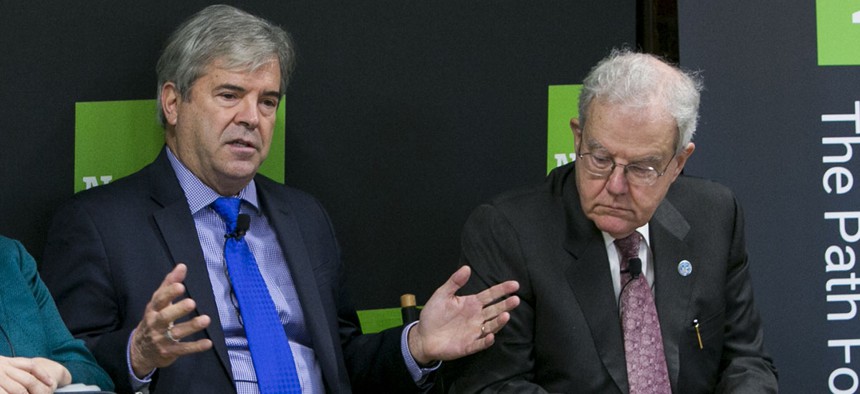IT Fund Gets a Thumbs Up from CIOs. But is $3 Billion Enough?

Transportation Department CIO Richard McKinney, left. Kristoffer Tripplaar
The federal government is planning to spend nearly $90 billion a year on IT next year.
The Obama administration’s proposal to create a $3 billion IT modernization fund to help agencies pay for much-needed system upgrades is getting the seal of approval from chief information officers and even a key congressional watchdog.
But some big questions remain. As the federal IT budget ratchets up to nearly $90 billion, is $3 billion enough to kick-start the rejuvenation of aging federal computer systems? And will Congress appropriate the necessary funding necessary to launch the new fund?
"Tackling our legacy IT is right at the top of the list,” of priorities, said Transportation Department CIO Richard McKinney during a March 8 webcast on IT modernization sponsored by Grant Thornton and produced by the custom events unit at Government Executive, parent company of Nextgov.
Under the administration’s proposal, agencies would have to apply for funding from the General Services Administration, which would administer the fund. Proposals would be evaluated by a panel of experts, who would apportion new funding in installments to incentivize incremental development.
Agencies would have to pay back their investments over time.
"This isn't just a pot of money that gets depleted,” McKinney said. “This is a self-perpetuating thing. You pay it back with real savings and the next great idea that comes forward -- the fund is intact and ready to take that on. The accountability is absolutely critical."
The federal government is planning to spend nearly $90 billion a year on IT next year -- 75 percent of that on operating and maintaining existing systems. Will $3 billion make a difference?
It’s probably too early to tell, but the fund is a good start, according to McKinney.
“If we do this well and the fund stays whole and ... we pick the right projects out of the gate” and they’re ultimately successful, “ I think there could be an opportunity down the road to say, 'Let's make the fund bigger; it's working,’ McKinney said.
But there might be a wrinkle.
"We want to have this fund be replenished through the savings, but so many of the really old legacy systems and capabilities, we aren't spending a whole lot of money on today,” said Joe Klimavicz, deputy assistant attorney general and CIO at the Justice Department. “They're off in the corner. They do a very valuable function. They keep the lights on, and they don't cost a lot.”
Modernizing those systems could deliver a whole bunch of new capability -- but might not always lead to immediate cost savings.
"I think if we look at this strictly as a business case to return dollars, that may not hit our most critical legacy systems,” Klimavicz added.
Dave Powner, director of IT management issues for the Government Accountability Office, said too few agencies are spending on modernizing their systems. Some agencies spend less than 10 percent of their IT budgets on new development. The proposed revolving fund could help “jump start” the modernization process in agencies, he said.
Still, the administration’s proposal, so far, has received a frosty reception in Congress. Chairman of the House Oversight and Government Reform Committee Rep. Jason Chaffetz, R-Utah, called the rationale for the fund “hogwash.” Other lawmakers say agencies could use the fund to circumvent the appropriations process.
Powner said agency CIOs are in a bind in trying to upgrade legacy systems.
“They gotta keep the lights running" -- keep existing systems running -- "and they've got these legacy systems ... that are very difficult to swap out,” he said.
In addition, GAO research has shown most agency tech chiefs are not in it for the long haul. The average tenure of an agency CIO is only about two years, which doesn’t bode well for many large-scale migration projects.
“Is that really something that someone wants to take on?” Powner said, adding, “It's a tall task."


